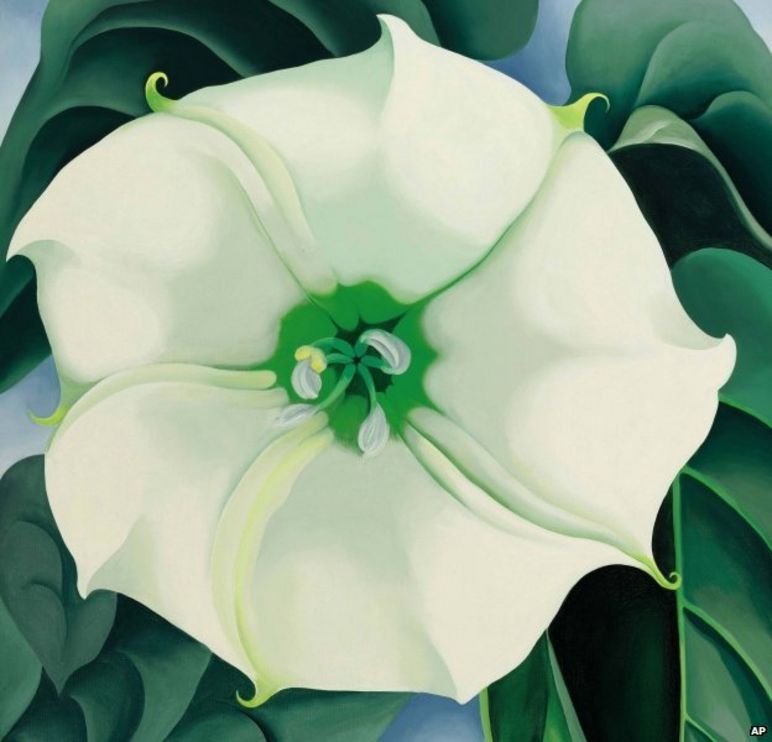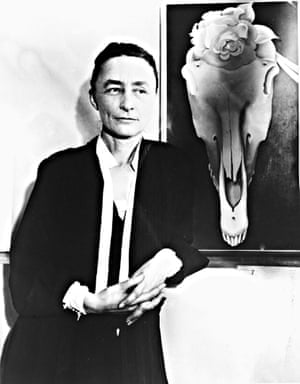“I have already settled it for myself so
flattery and criticism go down the same drain and I am quite free,” as she once
said. “Someone else’s vision will never be as good as your own vision of your
self.”
– Georgia O’Keeffe
When one thinks of
prominent female artists, Georgia O’Keeffe is undoubtedly in the top five of
most people’s list. Despite entering a field dominated by male artists,
curators, gallery owners, she was able to establish herself as one of the
foremost female artists of the 20th century, with a distinct
artistic style all her own. Once O’Keeffe moved to New York she had several
gallery exhibitions, but her first retrospective was in 1927 at the Brooklyn
Museum, featuring her most famous artistic subject-her flower close-up
paintings which she produced throughout the 1920’s. Her body of work spanned
seven decades, participating in the beginning of the American Modernist
movement, her paintings of flowers and desolate landscapes were portrayed
through an abstract lens conveying the emotional power of the objects.
Her most famous paintings were of course her magnified,
large-scale exploration of flowers, which many at the time and still continue
to argue is actually representative of female genitalia. O’Keeffe herself has
vehemently denied this one-dimensional sexist assumption/interpretation of her
paintings. In recent years, O’Keeffe’s work has had a large retrospective at
the Tate Modern in London. The Tate Modern’s director of exhibitions said this
of O’Keeffe’s work:
“O’Keeffe has been very much
reduced to one particular body of work, which tends to be read in one
particular way…Many of the white male artists across the 20th century have the
privilege of being read on multiple levels, while others – be they women or
artists from other parts of the world – tend to be reduced to one conservative
reading. It’s high time that galleries and museums challenge this.”
Georgia O’Keeffe herself bucked against this
sexist reading of her work, especially since most of the art critics of her day
were white upper-class men. If her paintings were in fact an exploration of
female sexuality, they greatly differed from the display of sexuality by male
artists, as explored in “Ways of Seeing” by John Berger: “Her body is arranged
in the way it is, to display it to the man looking at the picture. This picture
is made to appeal to his sexuality. It has nothing to do with her sexuality.”
(55) Of course male art critics of the day, used to females being painted in a
way that only appealed to their lens of sexuality, would have a problem with
O’Keeffe’s soft but emotionally powerful exploration of the female subject. Clearly
this criticism didn’t effect Georgia’s work or popularity, as she recently set
the record for the most expensive
artwork sold by a female artist at auction (44.4 million).
 |
| O'Keeffe's record setting work sold at auction for $44.4 million |
Paul
Rosenfeld, a more enlightened male critic, spoke of O’Keeffe’s work as such: “No man could feel as Georgia O’Keeffe and utter
himself precisely in such curves and colors; for in those curves and spots and
prismatic color there is a woman referring the universe to her own frame…
rendering in her picture of things her body’s subconscious knowledge of itself…
What men have always wanted to know and women to hide, this girl sets forth.”
The power of her paintings stem from her mastery of line, composition, and
color. Her paintings seem to have a vibrant glow that capture the emotion of
commonplace subjects. What made her such
a gift to feminism and the art world was the fact that she didn’t let her
status of being a female artist define her work. Much as Judith Butler affirmed
in her piece ‘Gender Trouble’; “If one ‘is’ a woman, that is surely not all one
is; the term fails to be exhaustive” (5). O’Keeffe wanted her work to transcend
her gender, a principle she brought to every aspect of her life.
 |
| O'Keeffe's signature androgynous style |
She rebelled
against her label as a strictly female artist with her stark, androgynous and
almost masculine everyday style documented throughout her life. Since there was
such a gender divide in the art world at the time, she seemed to buck against
that by removing gender from her work and personal
style, a true original in every sense of the word. The concept of Feminist
Masculinity seems to be in line with O’Keeffe’s views : “Feminist masculinity does
not come at the cost of femininity, it is a contextually specific enactment of
self that embraces the complexity of gender expression, a way to conceptualize
performances of masculinity in tandem with performances of femininity.” (47)
-Butler, Judith. “Gender Trouble: Subjects of
Sex/Gender/Desire” Routledge, 1990.
-Nydia Pabon-Colon, Jessica. “Performing Feminism in the Hip
Hop Diaspora” NYU Press, 2018.
-Berger, John. “Ways of Seeing” Penguin Press, 1972.
No comments:
Post a Comment